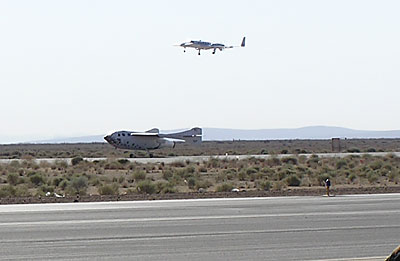SpaceShipOne makes history — barely<< page 1: things that go bang in the flight Success and future plansDespite the problems experienced during the flight, SpaceShipOne succeeded in what Rutan and financial backer Paul Allen set out to do: be the first privately-developed manned vehicle to fly into space. At the press conference Rutan clutched a printout of data from the vehicle’s internal navigation system, showing it had reached a peak altitude of 328,491 feet—just 124 meters over the 100-kilometer threshold. The altitude needed to be confirmed by radar tracking from nearby Edwards Air Force Base; as of late Wednesday that information had not been posted on the Scaled Composites web site. With that success came some pomp and circumstance. Patti Grace Smith, the FAA associate administrator for commercial space transportation, awarded Melvill with astronaut wings, the first ever given out by the FAA. “The flight today opens a new chapter in history, making space access within the reach of ordinary citizens, like you and me,” she said. Later, a representative of Guinness World Records awarded Scaled Composites a certificate for their history-making flight. However, the problems experienced during the flight, most notably the roll trim issue, made it clear that there were still some obstacles standing between Scaled and the $10-million Ansari X Prize. “There is no way we would fly again without knowing the cause [of the roll trim problem] and without assuring that we have totally fixed it, because it’s a very critical system,” Rutan said. “The anomaly we had today is the most serious flight safety problem we have had in the entire program.”
Rutan suggested that SpaceShipOne may fly one or more additional test flights before making its run at the prize. “If this flight today had been perfect, we had planned for the very next flight to be first X Prize flight,” he said. Given the anomalies, he said he wasn’t sure yet whether additional flights were needed. “In the next several days we will make a decision and then announce to X Prize.” The real power of imaginary linesThe fact that Scaled can claim some success with the flight involved some degree of luck. SpaceShipOne made it into “space”—that is, beyond 100 km—by less than 125 meters, barely more than the length of a football field. Had the roll trim problem started an instant earlier, or taken a split-second longer to correct, SpaceShipOne might well have come up a similar distance shy of 100 km, and that could have made all the difference in the perception of the flight. For that, we have an arbitrary definition to blame. In the 1950s an informal group of aeronautical scientists, led by Theodore von Karman, sought to define an altitude at which space began for the purposes of, among other things, ensuring that existing aviation records for speed and altitude would not be shattered by spacecraft. That group calculated an altitude below which “significant” thrust would be required to keep an object in orbit. Those calculations were done in units of nautical miles, and the resulting figure was, according to one scientist, a “very uneasy number to remember.” Von Karman then suggested a nice round number, 100 kilometers, which was near the number they calculated, as an alternative. This was eventually accepted by the Fédération Aéronautique Internationale, and is sometimes called the Karman Line in his honor. The X Prize later accepted this figure for its competition; prize founder Peter Diamandis noted that they had considered setting an altitude requirement of 100 miles, but rejected that after potential contenders noted that this higher altitude would be much more difficult to achieve. There is nothing that significant about 100 km; conditions there are little different than at 95 or 105 km. Indeed, it is not the only definition for space: the Air Force (and now the FAA) award astronaut wings for those who exceed an altitude of 50 miles (80.5 km). However, thanks in large part to the X Prize, 100 km is now perceived by the media and the public as the boundary of space, an imaginary line where the final frontier begins.
While we can dismiss this boundary as having little scientific merit, it does have real significance. People are often fascinated by these arbitrary boundaries, drawn up by people rather than geography or science; they love, for example, to have pictures of them taken straddling such a state or national border. Of course, the positions of those arbitrary borders can have far more serious geopolitical implications as well. So, like it or not, we are most likely stuck with 100 km as being the “boundary” of space. This makes SpaceShipOne’s flight Monday very fortunate. Had it fallen a bit short—say, 99.9 km altitude instead of 100.1 km—the flight might well have been perceived as something of a failure. After all, this was the flight that was supposed to go to space, and that arbitrary boundary of space is 100 km. From an engineering standpoint the difference would have been trivial, but in the media we might have read articles about how SpaceShipOne came up short in its bid to reach space. Close, but no cigar. So, Rutan and company should feel at least a little bit lucky. Lucky that the problems experienced during the flight could be corrected to allow SpaceShipOne and Mike Melvill to return safely, and lucky that the problems took place, and were corrected, when they did. They should also perhaps feel lucky that Theodore von Karman liked nice, round numbers and the metric system. Home |
|
